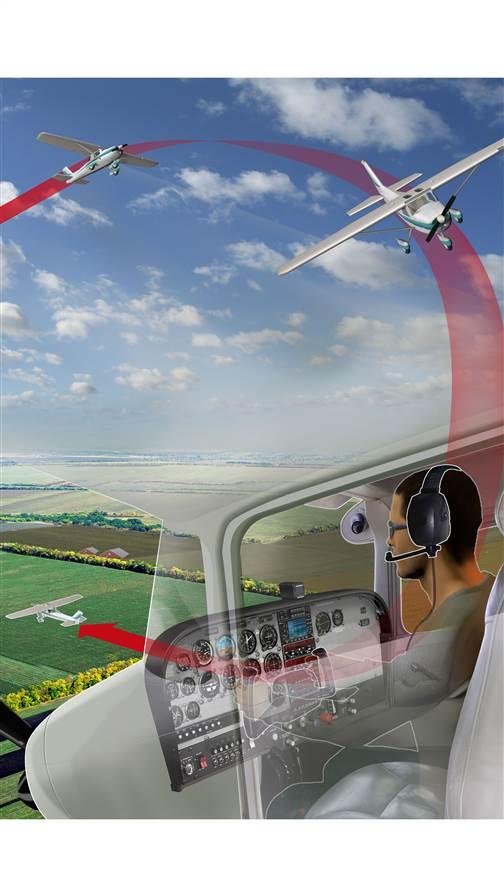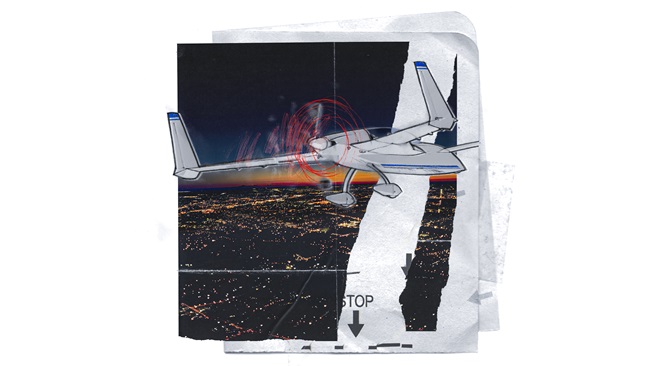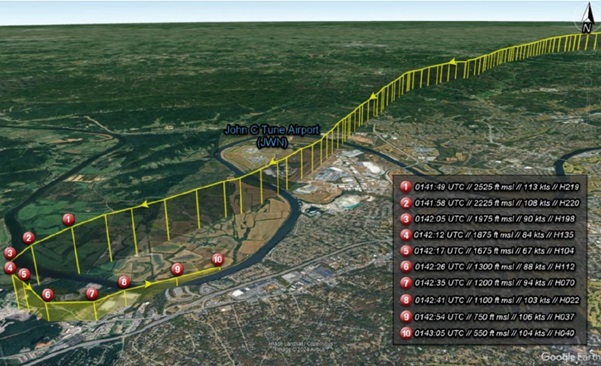Engine Out
Tips for approaching the unexpected

Engine failures happen. Prepare for the possibility by practicing simulated engine-outs and emergency landing procedures with an instructor—and considering the psychological hazards that may affect your reaction to a real emergency.
For safety reasons, most of a pilot’s training for emergency landings takes place over suitable terrain. But sometimes engine failures happen when you’re flying over congested areas, forests, or just after takeoff. Pilots may not act appropriately because of fear and lack of training.
Although pilots should make a habit of keeping an eye on the nearest suitable landing site during flights, sometimes there is no nearby airport with relief-inducing runways—or even an open field. How about landing on water? Or in a cornfield? The techniques are similar, but fear may cause you to approach these landing sites differently. That makes it a lot more difficult to do the single most important thing you can do in an emergency: Fly the airplane.
The good news
The good news is that pilots have landed on the tops of trees, in rivers, and in cornfields safely and effectively. These types of landings are very similar, with just slight differences. Contact with the ground should always be made at the minimum controllable airspeed. If landing in trees, choose shorter, closely spaced trees with dense tops. Make contact at an appropriate attitude that will distribute the impact energy evenly along both wings. Maintain a nose-high landing attitude, which will allow the wings and fuselage to provide a cushioning effect. A full-flap configuration is recommended. As normal, land into the wind if possible to help minimize your groundspeed.
Be extra cautious when landing on roads. It’s important to avoid obstacles such as power lines or street lights, which may not be visible until just before ground contact. These can snag and damage the wing, which may lead to a dangerous yawing of the aircraft and an unpredictable ground track. Normal use of flaps is recommended on approach. Refer to your pilot’s operating handbook if flying an aircraft with retractable landing gear for recommendations on landing gear configuration when landing on soft or rough terrain.
When performing an emergency landing on water (ditching), a gear-up configuration is recommended for retractable-gear aircraft unless your pilot’s operating handbook recommends otherwise. On low-wing airplanes, fully extended flaps on contact may cause asymmetrical flap failure, so use no more than an intermediate flap configuration. If flying over water, always have flotation devices on board. Flying over or landing at a safe distance from nearby boats is encouraged.
This helped a pilot from Sarasota, Florida, and his passenger receive assistance more quickly when the pilot made an emergency landing in shallow water. A man in a nearby boat called authorities and transported them to a Coast Guard vessel, where paramedics evaluated them. Neither suffered any injuries.
Low altitude
When an engine failure happens at a low altitude, as in a climb from takeoff, fewer options are available. Remember that you’ll have to push the yoke forward—a lot—to maintain airspeed, something very difficult to do when close to the ground. With insufficient altitude to make an immediate turn back to the takeoff runway, use caution not to overextend your glidepath, and avoid steep bank turns. Select a landing site as straight ahead of you as possible, using slight turns only. This provides you with the most time to establish the proper attitude and land at the slowest controllable airspeed.
When making an emergency landing, slower is safer. Higher speed equals higher impact energy. Always land at the minimum airspeed at which the airplane is still controllable. It’s also important to choose a landing site with a clear approach zone. Hitting rough objects such as small trees and brush on the ground at a slower speed is much safer than if you were to hit an obstacle just a few feet high while attempting to land. These objects can help slow your airplane down after making contact with the ground.
Landing in dense vegetation, such as a corn or grain field, also can provide critical impact energy absorption. Dense vegetation helped soften the impact of an emergency landing by a pilot in Bismarck, North Dakota, who had noticed a problem during the takeoff run. Instead of aborting the takeoff as the end of the runway approached, he climbed and found a wheat field to his left. The pilot did not suffer any injuries.
Other factors such as wind direction, wind velocity, and slope and dimensions of the landing site should be considered, but not at the expense of an unobstructed approach path. Landing in a slight crosswind or tailwind is sometimes necessary. A long, flat field may not be within a safe flying distance. There is some relief, however. Light airplanes are built to withstand deceleration forces up to 9 Gs. That means that less than 10 feet of landing distance is required at a speed of 50 miles per hour. Slower is safer.
In case of emergency
If you’re forced to make an emergency landing, concentrate on the task at hand and control the airplane to the best of your ability. This will make the landing as safe as possible under the circumstances. This helped save a quick-thinking pilot flying over West Milford, New Jersey. Unable to find a field or lake to land in, he flew toward a highway that he located with help from his GPS. He landed his Cessna 150 on the road, and while the airplane did clip a tree while decelerating on the ground, he walked away uninjured. Safely on the ground, he called 911.
Pilots may also fear damaging the airplane. There are times, however, where this is unavoidable. It is far better to sacrifice the airplane and walk away than to try and preserve it by stretching out your glide and attempting to land in a different area. The wings, landing gear, and front and bottom of the fuselage are part of your protection. You should use it when necessary.
You may fear that injury or even death is unavoidable during an emergency. But many pilots not only survive, they walk away uninjured from forced landings. The only way to make full use of all the skills you have as a pilot is to control your fear of the situation.
Emergency landings can be a very frightening experience. Fear can paralyze even the most experienced pilot, causing him or her to lose control of the airplane—or delay executing the necessary maneuvers to land safely. But by maintaining your composure and applying some general techniques, these landings can be made safely and without injury. Be resourceful and focus at the task at hand. Remember: Always fly the airplane.

Stopped prop
Your engine failed. Now what?
Pitch for best glide. The best glide speed published in your aircraft’s pilot’s operating handbook will allow you to travel the maximum horizontal distance to reach your emergency landing site.
Select a landing site. If no airport is within gliding distance a flat, open farm field with low crops is a good choice. If you’re at a high altitude, select a general area and pinpoint the best spot once you’ve descended to where you have a better view of terrain. Once you pick a spot, commit to it unless you find one that is obviously better.
Turn to the landing site. Make an immediate turn to the site you’ve selected.
Try to restart the engine. Is your fuel selector on the correct tank? Carb heat on? Check your throttle, mixture, and magnetos.
Call for help. Set the transponder to 7700 and make a Mayday call—to ATC if you’re already talking to them or on 121.5 MHz.
Fly a normal pattern. The terrain may be unfamiliar, but the procedure doesn’t have to be. Set yourself up in a pattern; fly it tighter than usual and extend flaps once you know you can reach the landing site.
Prepare for touchdown. Turn off the fuel supply, master switch, and magnetos. Open the doors so they won’t get jammed.
Land. Use technique appropriate to the terrain and land as slowly as possible—just like you’ve practiced.
Get more insight from the AOPA Air Safety Institute’s video Engine Out! From Trouble to Touchdown.


